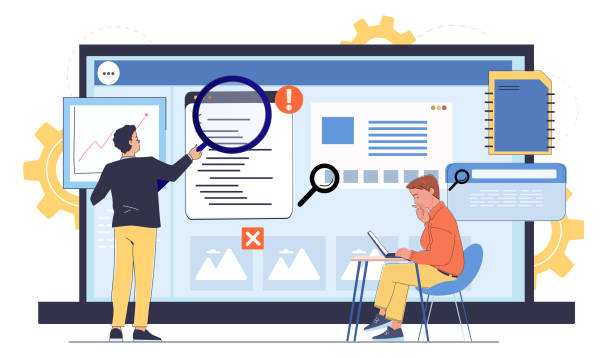Introduction to the Importance of Secure Website Design

In today’s fast-paced world, websites are considered the lifeline of every business.
From online stores to service platforms, all rely on a powerful and reliable #online_presence.
In this regard, secure website design is not an option, but a necessity.
With the increasing cyber threats, loss of customer data, server breaches, and damage to brand reputation can have disastrous consequences.
This section explains the inherent importance of secure website design and the need to prioritize it in every web project.
The main goal is to help businesses and web developers, with full awareness, embark on the path of building websites that are not only beautiful and functional but also highly resistant to cyberattacks.
The importance of website security, both for protecting sensitive user information and for maintaining the integrity and accessibility of online services, is undeniable.
In fact, any negligence in the field of cybersecurity can lead to loss of user trust and, ultimately, business bankruptcy.
Therefore, a deep understanding of the principles and solutions for secure website design is the first step towards building a sustainable and reliable digital infrastructure.
Is your online sales not as expected? With Rasab, permanently solve the problem of low sales and poor user experience!
✅ Increase visitor-to-customer conversion rate
✅ Create an enjoyable user experience and increase customer trust
⚡ Act now for a free consultation!
Common Cyber Threats and Preventive Solutions

Knowing the enemy is the first step to victory in any battle, and in website security, this enemy is the diverse and complex cyber threats that are constantly evolving.
This specialized section examines the most common threats that can compromise your website’s security and provides practical solutions to combat them.
From SQL injection attacks that aim to access databases, to cross-site scripting (XSS) attacks that can execute malicious code in users’ browsers, and Denial-of-Service (DDoS) attacks that paralyze the website with fake traffic, all require precise understanding and smart defensive strategies.
For a secure website design, these threats must be considered from the outset.
Practical guidelines include using Web Application Firewalls (WAFs), implementing strong input validation mechanisms, restricting access, and continuously monitoring website traffic.
These preventive measures form the backbone of a secure web platform and significantly help in protecting user information and website performance.
The OWASP Top 10 project is an excellent resource for awareness of the most common web vulnerabilities that every web developer should be familiar with.
Countering these threats not only requires technical knowledge but also a comprehensive and continuous approach in the secure website design process.
The Role of Security Protocols in Secure Website Design
![]()
Security protocols are the backbone of secure communications in the web world and play a vital role in secure website design.
The most important of these protocols is HTTPS, which is composed of HTTP and SSL/TLS.
This specialized section explains how HTTPS encrypts information between the user’s browser and the web server, preventing eavesdropping, tampering, or forging of information.
The use of SSL/TLS certificates not only builds user trust (by displaying a lock icon in the browser’s address bar) but is also highly important for website SEO; search engines like Google rank HTTPS-enabled websites higher.
The process of obtaining and installing an SSL certificate, choosing the appropriate type of certificate (Domain Validated, Organization Validated, Extended Validation), and regularly renewing it, are among the key steps in ensuring web security.
In addition to HTTPS, other protocols such as DNSSEC (for securing DNS) and HSTS (HTTP Strict Transport Security) also exist, which contribute to the overall security of a website.
HSTS forces the browser to always use HTTPS to connect to the website, even if the user enters the URL with HTTP, which prevents “Man-in-the-Middle” attacks.
Correct implementation of these protocols requires sufficient technical knowledge, but the result is a secure and reliable website that protects user information from cyber threats.
| Protocol | Primary Function | Importance in Web Security |
|---|---|---|
| HTTPS (HTTP Secure) | Encrypts communication between browser and server | Protects data privacy, prevents information tampering, gains user trust, improves SEO |
| SSL/TLS (Secure Sockets Layer/Transport Layer Security) | Provides the cryptographic foundation for HTTPS | Ensures data confidentiality and integrity, server authentication |
| HSTS (HTTP Strict Transport Security) | Forces browser to use HTTPS | Prevents Downgrade attacks and some Man-in-the-Middle attacks |
| DNSSEC (Domain Name System Security Extensions) | Secures the Domain Name System | Prevents DNS spoofing and Cache Poisoning attacks |
Database Security and Data Management

The database is the heart of any dynamic website and contains the most valuable information, including user data, transaction records, and site content.
Therefore, database security is one of the most important aspects of secure website design.
This section provides expert guidance on protecting your database from intrusion and unauthorized access.
SQL Injection attacks are among the most common and dangerous threats against databases, allowing an attacker to access or even modify sensitive information by injecting malicious SQL code into website inputs.
To counter this attack, using Prepared Statements or ORMs (Object-Relational Mappers) and strict input validation is essential.
Furthermore, proper management of user access and privileges in the database, using strong and complex passwords for database accounts, and enabling Database Firewalls are also vital measures.
Additionally, encrypting sensitive information in the database, both at rest and in transit, provides another layer of security.
Planning for regular and automatic database backups and testing their restorability ensures that data will be recoverable in the event of any disaster.
This analysis shows that database security requires not only technical knowledge but also a comprehensive strategy for data protection throughout the entire website lifecycle.
Tired of losing business opportunities due to not having a professional corporate website? Don’t worry anymore! With Rasab’s corporate website design services:
✅ Your brand’s credibility and professionalism will increase.
✅ You will attract more customers and sales leads.
⚡ Get a free consultation now to start!
The Importance of Regular Updates and Maintenance

In a cyber world where threats are rapidly evolving, secure website design is not a static process; rather, it requires continuous maintenance and updates.
This informative and guiding section emphasizes the critical importance of regular updates and active website maintenance.
Software used on websites, including Content Management Systems (CMS) like WordPress or Joomla, development frameworks, plugins, and even server operating systems, may contain vulnerabilities that attackers can exploit.
Software development companies continuously identify these vulnerabilities and release security patches.
Failing to apply these updates means leaving the door open for intruders.
Furthermore, continuous monitoring of the website to identify suspicious activities, regular scanning for malware and vulnerabilities, and reviewing server logs are among the active maintenance measures.
A secure website requires constant attention.
This proactive approach not only protects your website from attacks but also ensures that you always benefit from the latest security defenses.
Any news regarding new vulnerabilities should be promptly followed up, and necessary actions taken to address them.
This dynamic approach to website security will guarantee the long-term stability and trustworthiness of your website.
User Authentication and Access Management

Strong authentication and precise user access management are fundamental pillars of secure website design.
This explanatory and specialized section examines various methods to ensure that only authorized users have access to specific information and functionalities.
The first step is to implement strong password policies that require users to use complex, long, and unique passwords.
Educating users about the dangers of using simple and common passwords is also very important.
The next step is to implement Multi-Factor Authentication (MFA).
MFA provides an additional layer of security, requiring the user to provide another factor (such as a code sent to a mobile phone or a fingerprint) in addition to their password for login.
This significantly reduces attacks resulting from password compromise and increases website login security.
Also, Role-Based Access Control (RBAC – Role-Based Access Control) ensures that each user only has access to the resources and functionalities they need to perform their duties.
For example, a system administrator has full access, while a regular user can only view their profile.
This precise approach prevents unauthorized internal or external access and helps maintain system integrity.
These guidelines are of great importance for any web platform and form the cornerstone of a fully secure website.
Secure Programming and Protected Frameworks

The root of many web vulnerabilities lies in improper and insecure coding.
This specialized and analytical section addresses the importance of secure programming and using reputable and protected frameworks in the secure website design process.
Choosing modern and up-to-date frameworks such as Laravel (for PHP), Django (for Python), Ruby on Rails (for Ruby), or ASP.NET Core (for C#) can significantly increase the website’s security level.
These frameworks internally manage many common attacks such as SQL Injection, XSS, and CSRF (Cross-Site Request Forgery), or provide tools to combat them.
However, even the best frameworks will be vulnerable if not used correctly by the programmer.
Some principles of secure programming include: Input Validation on both server and client sides to ensure that entered data matches the expected format and type; filtering and sanitizing output (Output Encoding/Escaping) before displaying it to the user to prevent XSS attacks; using prepared statements in database queries; proper error management and secure logging; and using strong hashing functions to store passwords.
While these measures require precision and time, they are an integral part of a secure web structure.
Development teams should regularly receive security training and use static and dynamic code analysis tools to identify and fix vulnerabilities in the early stages of development.
A secure web platform is rooted in its code layers from the very beginning.
| Security Principle | Description | Importance in Countering Attacks |
|---|---|---|
| Input Validation | Checking and sanitizing all user inputs before processing | Prevents SQL Injection, XSS, and other injection-based attacks |
| Output Encoding/Escaping | Encoding or sanitizing data before displaying in the browser | Protects against XSS attacks |
| Using Prepared Statements | Separating SQL code from input data | Effective prevention of SQL Injection attacks |
| Proper Error Management | Displaying generic error messages and preventing sensitive information disclosure | Prevents Information Disclosure attacks |
| Using Strong Hashing Functions for Passwords | Storing passwords as hashed (one-way) with Salt | Protects passwords in case of database breach |
Penetration Testing and Vulnerability Assessment
![]()
Even after implementing all secure website design solutions, ensuring their effectiveness requires precise and continuous testing.
This analytical and specialized section discusses Penetration Testing and Vulnerability Assessment methods.
Penetration testing is a simulated and controlled attack on your website performed by security specialists (ethical hackers) to find weaknesses and vulnerabilities.
The goal of this test is to identify security gaps before real attackers discover and exploit them.
The results of a penetration test include a comprehensive report of discovered vulnerabilities and practical solutions to address them.
Vulnerability assessment also involves using automated tools to scan the website and identify known vulnerabilities.
Although this method is not as comprehensive as penetration testing, it can help identify problems regularly and at a lower cost.
Bug Bounty programs are also a novel and engaging approach to encourage security researchers to find vulnerabilities on your website in exchange for financial rewards.
These programs can add a significant security layer to your website’s security.
Continuous monitoring and regular execution of these tests are an integral part of the lifecycle of a secure website, ensuring that even after launch, your website’s security is maintained and keeps pace with new threats.
Does your current e-commerce website design lead to lost customers and sales?
Rasab is your solution with modern and user-friendly e-commerce website designs!
✅ Significant increase in conversion rates and sales
✅ Strong branding and building customer trust
⚡ Get a free e-commerce website design consultation from Rasab!
Incident Response and Disaster Recovery Planning

In the realm of secure website design, no matter how many preventive measures you take, there is always a possibility of a successful attack.
Therefore, having a comprehensive Incident Response Plan and Disaster Recovery Plan is of vital importance.
This informative and guiding section explains how to prepare for a security incident and how to recover quickly if one occurs.
The incident response plan should include specific steps: incident identification, containment, eradication of the threat, system recovery, and finally, learning from the incident to prevent its recurrence.
Preparation includes having an incident response team, advanced monitoring tools, and internal and external communication protocols.
Furthermore, regular and automated backups of all website data and code in secure, off-site locations, and periodic testing of these backups’ restorability, are an inseparable part of any disaster recovery plan.
This ensures that in case of data loss due to a cyberattack, hardware failure, or natural disaster, the website can quickly return to normal operation.
Not having such a plan can lead to complete data loss and prolonged downtime, which is catastrophic for any online business.
Web security is not just about preventing attacks, but also about preparing for worst-case scenarios and being able to recover quickly from them.
The Future of Secure Website Design and Upcoming Challenges

The world of cybersecurity is constantly evolving, and with the emergence of new technologies, new challenges also arise in the field of secure website design.
This analytical and thought-provoking section explores the future landscape of web security and the challenges that developers and businesses will face.
One of the most important trends is the use of Artificial Intelligence and Machine Learning on both sides of the battle: both for discovering and predicting cyberattacks (such as detecting anomalies and suspicious traffic patterns) and for executing more sophisticated and targeted attacks by adversaries.
The question arises whether humans can fight these advanced attacks alone, or if we need to rely on automated and intelligent tools? The advent of the Internet of Things (IoT) and the proliferation of connected devices have significantly expanded the attack surface, making securing these complex connections a major challenge.
Furthermore, the discussion of data privacy and regulations like GDPR and CCPA obliges developers to incorporate privacy into their website design (Privacy by Design) from the outset.
Challenges related to blockchain and Web 3.0 also open new horizons for website security.
Secure website design in the future will require a very agile, proactive, and globally collaborative approach to combat unknown and more complex threats and ensure user security in the digital space.
Frequently Asked Questions
| Question | Answer |
|---|---|
| 1. What does secure website design mean? | Secure website design means creating a website that is resistant to cyberattacks and protects user and server information. |
| 2. Why is security important in website design? | To prevent data breaches, protect user privacy, maintain user trust, and avoid financial and reputational losses. |
| 3. What are the most common web vulnerabilities? | SQL Injection, Cross-Site Scripting (XSS), Cross-Site Request Forgery (CSRF), Broken Authentication, and Security Misconfiguration. |
| 4. How can SQL Injection be prevented? | By using Prepared Statements / Parameterized Queries, ORMs, and Input Validation. |
| 5. What is the role of HTTPS and SSL/TLS in site security? | HTTPS uses the SSL/TLS protocol to encrypt communication between the user’s browser and the server, preventing eavesdropping and data tampering. |
| 6. What measures should be taken to prevent XSS attacks? | Input validation, output encoding to prevent malicious code execution, and using Content Security Policy (CSP). |
| 7. What does a strong password policy include? | Requiring the use of long passwords, a combination of uppercase and lowercase letters, numbers, and special characters, and preventing reuse. |
| 8. How does Two-Factor Authentication (2FA) help with security? | Even if the user’s password is compromised, the attacker cannot access the account without access to the second authentication factor (such as an SMS code or an application). |
| 9. What is a Web Application Firewall (WAF) and what is its purpose? | A WAF is a firewall that monitors and filters HTTP traffic between a web application and the internet to prevent common web attacks such as SQL Injection and XSS. |
| 10. Why are regular updates of software and libraries important? | Updates often include security patches to fix discovered vulnerabilities. Failure to update can expose the site to new attacks. |
And other services of Rasab Advertising Agency in the field of advertising
Ways to increase customer loyalty with medical product advertisements
How to use augmented reality in medical product advertisements?
Tips for choosing ad size for display on industrial websites
How to simplify advertisements for beginner audiences in the medical field?
Using big data to improve medical product advertisements
And over a hundred other services in the field of internet advertising, advertising consultation, and organizational solutions
Internet Advertising | Advertising Strategy | Advertorial
🚀 Are you ready to revolutionize your business in the digital world? Rasab Afarin, a leading digital marketing agency, paves your path to growth by offering comprehensive services including custom website design, SEO, and advertising campaign management.
📍 Tehran, Mirdamad Street, next to Bank Markazi, Kazerun Jonoubi Alley, Ramin Alley, No. 6


